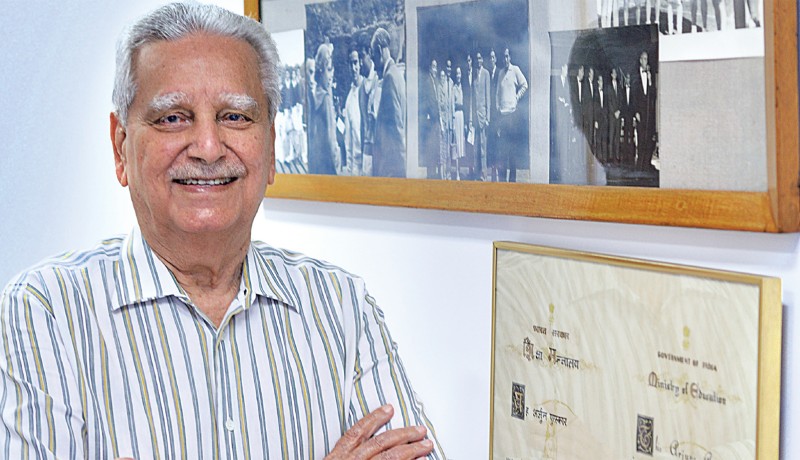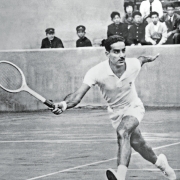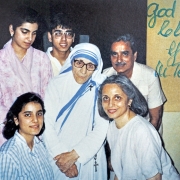
People

Tennis legend Naresh Kumar relives the golden moments of his career in a chat with Partha Mukherjee
Naresh Kumar is many people rolled into one: sports commentator, successful businessman, tropical aquarium fish breeder and art collector. But he is most fondly remembered for his pioneering role in taking Indian tennis to the world stage.
Along with Ramanathan Krishnan, Kumar ruled Indian tennis for over a decade in the 1950s and 60s. And together, they were considered one of the top doubles teams in the world, which led the British Tennis Authority to suggest that “Kumar & Krishnan were two of the finest sportsmen on the court….”
At the age of 89, Kumar is now a grand old man, having built a coal trading company in his post-tennis days; but he exudes the air of a man who has defied time. Walking into his sparse yet tastefully decorated office in Kolkata, M F Husain’s angular horses gallop across the walls of the sprawling chamber, reminding us as much of Kumar’s patronage of the ‘barefoot artist’ as his stallion-like will to succeed. These days he makes it to the office for a couple of hours, although the reins have now passed to his son.
Past the paintings, one notices a treasured glass chamber on the wall next to Kumar’s desk, which houses monochromatic memories of his past life: the tennis champion and his Davis Cup teammates meeting then President Rajendra Prasad; conferring with then Prime Minister Jawaharlal Nehru; and most splendid of all, a picture of a lanky and athletic player dwarfed by the Wimbledon court. Below, as acknowledgement to the stories that the photographs tell, hangs the Arjuna Award conferred on him in 1962.
At barely 21 years of age, Kumar played on the foreign circuit. Armed with a wooden Slazenger racket and an Air India kit bag slung over his shoulder, he played the finals at the 1949 North of England Championships at Manchester, his first foreign tournament. “I lost to Tony Mottram, who was No. 1 in the UK, but won the doubles title with Mottram as my partner,” Kumar remembers.
By 1951, he was regularly playing at Wimbledon and making swift strides up the rankings, even reaching the Top 16 in the 1956 Wimbledon singles game. And with Krishnan as his partner, he played a handful of doubles and mixed doubles games over that decade. In fact, The Daily Telegraph dubbed Kumar as “one of the most popular figures in lawn tennis”. Ramanathan Krishnan tells us why: “His sense of humour and ready wit kept us rejuvenated on the circuit. He was quick to crack jokes, even on himself.”
Through a career spanning 20 years, Kumar represented India at Wimbledon and Roland-Garros (where the French Open Championship is played) and led the Indian Davis Cup team as playing and non-playing captain for several years. Close to retirement from active sports, in 1963, Kumar turned to the commentary box to keep him close to his beloved game and continued the tradition of attending Wimbledon year after year, long after he had stepped out of the commentary box for good.
Kumar may be on the verge of turning 90 but his achievements are still being recognised; earlier this year, he was awarded the Jeevan Kriti Samman Lifetime Achievement Award by the West Bengal government for his contribution to sports. We visited him at his office and strolled down memory lane with the tennis legend.
EXCERPTS FROM THE INTERVIEW
How did tennis happen for you?
I was about 12 when I saw an advertisement in the papers. So I enrolled myself as a trainee at a coaching camp by the Bengal Lawn Tennis Association, in South Club [Kolkata]. We could practise twice a week for half an hour, free of cost. After training for three years, the association saw no talent in me. But I was very committed and started taking private lessons, twice a week, from S J Mathews, one of the coaches at South Club.
You had to return to Lahore, the city of your birth, quite unexpectedly….
Yes, my father sent me back to Lahore when World War II broke out and its effect was felt on the city.
Returning to Lahore under such circumstances, were you able to pursue tennis?
Yes, the courts were meant for players of higher standards in Lahore, where I lived for three-and-a-half years. This made me a much more competent player. I enrolled in Government College, where I mingled with seniors such as Dev Anand, Keshub Dutt and many others who went on to become greats in their respective fields. The college itself gave my tennis career a huge fillip. It had the best facilities for tennis: six courts graded A, B and C, with C being the lowest court. To play in Court A, one had to beat a player from courts C, B and finally A. The competitiveness inherent in the arrangement was enough to egg me on to give my best. As I was already trained in tennis, I started on Court B and was always challenging Court A players. The British had a wonderful system that was essential for those who aspired to do well in sports.
What was the routine like when you returned to Calcutta? Could you pick up where you left off?
I came back to Calcutta in 1946. Those were very tough and hectic days for me. After attending college in the morning, I had to race to my father’s office to help him in his coal trading business. Then I would rush home to grab a quick lunch and finally land up at South Club or Punjab Club for a gruelling round of tennis. Taj Mohammed and Noor Mohammed, excellent sibling coaches, were appointed by my brother Suresh to practise with me.
What was your earliest win?
I still fondly recall the game in which I beat Jiten Chowdhury, another promising youngster in Calcutta in those days, and bagged the Junior National Champion title for 1945-46. By 1948, I was about 20 years old and I already held a national rank and had won several regional and national titles.
There was one great foe who thwarted you from winning the Nationals….
Yes, I never won a National title as Ramanathan Krishnan and ranked foreigners had started playing in the tournament by then. But I did win the doubles titles six times with Krishnan, and the mixed doubles with Khanum Singh, who had come to India from Karachi. In her younger days, she was the most glamorous lady in the tennis world.
How did it feel to beat Krishnan at last?
I beat the great Krishnan at the Frinton-on-Sea tournament in the UK in the finals in 1957. Of course, it was a great feeling to win against an all-time great. I must confess that the court was wet, which went against Krishnan, who was not an athletic fellow. I could run well on a wet court.
Was that your advantage on court?
Yes, my tenacity. If not for that, I would never have pulled off some of those victories from the brink of defeat. The match against Tony Mottram of Britain comes to mind, where I was trailing badly. But I managed to turn the match around and claw my way to victory. Mottram lead me 5-3 and 30-15 in the fifth set but I retrieved a seemingly impossible shot from Mottram. In all my matches, I fought till the very last point.
Were there any advantages playing on home turf?
Yes, in a way, and the weather played a considerable role too. My most memorable match was my victory over Sven Davidson in the Asian Championships in I956 at South Club. At that time, Davidson was ranked No. 5 in the world. The scorching midday sun sapped the strength from the tall and muscular Scandinavian and he looked quite dazed at the end of the four-set match.
What were some of the challenges getting to the foreign circuit in those days?
It was very difficult to get financial support back then. There was no such thing as a sponsor for Indian players. Some well-wishers gave me some money but it was my elder brother Suresh who has provided most of my financial support.
You played more than 100 matches in 19 years. What is your most cherished memory while representing the country?
My greatest moment was at Wimbledon, when Ramanathan and I beat Budge Patty and Gardner Mulloy, the reigning champions and the No. 1 doubles seeds. It was the pre-quarter final of 1958.
How did you manage to navigate the circuit abroad and at home?
Usually, after Wimbledon, I would play in the UK and stayed away from home for about six months and then return home from England to work with my father in his coal-trading business and my brother in his many business enterprises. In those days, the coal firms were headed mainly by the British, who knew me because of my tennis. This helped my father procure business from them. My father died of cancer in 1959. While I was abroad, I received a message from home that he was not well. Krishnan and I had just won the doubles in Manchester. When I returned home, Wimbledon sent me a telegram wanting to know if I would make it back, as they were going to seed me and Krishnan No. 3 or 4 in doubles. My father advised me to return but I refused. I stayed with him for six months until he breathed his last. In those days, there were no good painkillers, so he suffered a lot. I couldn’t leave him. It was a great setback for my career but my father’s blessings more than compensated for that.
How did you make the switch from the court to commentary box?
I started to commentate in English in the latter years of my playing career. I had developed a flair for it by listening to the great cricket commentators of my time Dan Maskell and John Arlot. My Wimbledon Roundup on radio was broadcast every morning for 15 minutes on every station of All India Radio for about 20 years. I also anchored the Olympic Games and the Asian Games on television.
Apart from your business interests, how do you keep yourself busy?
I have been associated with Mother Teresa’s Missionaries of Charity along with my wife, who is their official spokesperson, and I am a member of many social clubs. I also work out at the gym every morning and spend the evening attending social gatherings, painting exhibitions and private film screenings.
How did you get interested in M F Husain’s paintings?
My wife Sunita is a very good painter. She instilled a taste for art in me and inspired me to collect art. But my interest in Husain grew because he had this amazing ability to hold forth on any subject, from films and poetry to music and art. We met him at a dinner party in 1963 and, ever since, our friendship grew. He would join Sunita and me every summer to watch Wimbledon and I would invite him to tournaments in India and Davis Cup matches.
Do your children share your love for sports, or do they have your business acumen?
We have been blessed with three lovely children. My son Arjun, a Cambridge graduate, has taken over the business mantle from me. My daughters, Gita and Preah, both happily married, are a painter and a culinary artist respectively. Both Arjun and Gita were very good at tennis but didn’t pursue it.
Photo: Shilbhadra Datta Featured in Harmony — Celebrate Age Magazine July 2017
you may also like to read
-
For the love of Sanskrit
During her 60s, if you had told Sushila A that she would be securing a doctorate in Sanskrit in the….
-
Style sensation
Meet Instagram star Moon Lin Cocking a snook at ageism, this nonagenarian Taiwanese woman is slaying street fashion like….
-
Beauty and her beast
Meet Instagram star Linda Rodin Most beauty and style influencers on Instagram hope to launch their beauty line someday…..
-
Cooking up a storm!
Meet Instagram star Shanthi Ramachandran In today’s web-fuelled world, you can now get recipes for your favourite dishes at….









